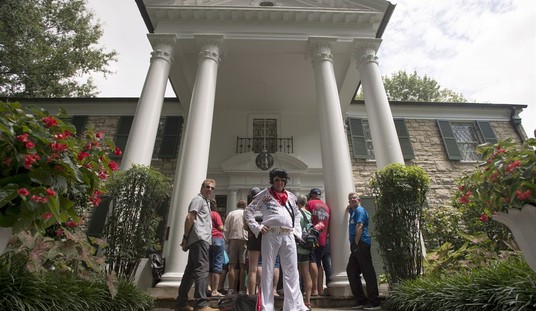Could the Paycheck Protection Program have missed the mark? Or would this have been a lot worse without it? That will take months or years of study to determine, but what we know right now is that the bleeding of the American workforce has not been stanched. Last week 3.8 million workers filed unemployment claims, according to the report today from the Department of Labor.
The rate of bleeding has slowed, but it’s still gushing, and the cash transfusions don’t appear to be making up the difference:
In the week ending April 25, the advance figure for seasonally adjusted initial claims was 3,839,000, a decrease of 603,000 from the previous week’s revised level. The previous week’s level was revised up by 15,000 from 4,427,000 to 4,442,000. The 4-week moving average was 5,033,250, a decrease of 757,000 from the previous week’s revised average. The previous week’s average was revised up by 3,750 from 5,786,500 to 5,790,250.
The advance seasonally adjusted insured unemployment rate was 12.4 percent for the week ending April 18, an increase of 1.5 percentage points from the previous week’s revised rate. This marks the highest level of the seasonally adjusted insured unemployment rate in the history of the seasonally adjusted series. The previous week’s rate was revised down by 0.1 from 11.0 to 10.9 percent. The advance number for seasonally adjusted insured unemployment during the week ending April 18 was 17,992,000, an increase of 2,174,000 from the previous week’s revised level. This marks the highest level of seasonally adjusted insured unemployment in the history of the seasonally adjusted series. The previous week’s level was revised down by 158,000 from 15,976,000 to 15,818,000. The 4-week moving average was 13,292,500, an increase of 3,733,250 from the previous week’s revised average. The previous week’s average was revised down by 39,000 from 9,598,250 to 9,559,250.
The total number of claims filed in the last six weeks now amounts to 30.3 million. That would be just shy of 20% of the American workforce prior to the coronavirus. CNBC notes that claims have declined every week since the period ending March 28, but each of these weeks would have easily been the worst week in US history on their own prior to mid-March. Even the decline from last week, a little over 600,000 claims, would have been a near-record for a week before the COVID-19 pandemic.
The sheer scope of these numbers raise questions as to whether the actual numbers for job losses is larger. States run the claims systems, and most of them had never prepared for job losses on this scale — literally, as the Wall Street Journal reports this morning:
The pandemic has led to an unprecedented tidal wave of initial claims for unemployment insurance, at least 26 million nationwide from mid-March through April 18. That would have been a challenge under any circumstance for states to manage.
In this case, the challenge is proving even greater because many states’ unemployment benefit systems are hamstrung by archaic, decades-old technology. Coping with relief legislation that provides an additional $600 a week in benefits and making independent contractors such as Uber drivers eligible has created additional strains.
In the years before the pandemic, computers that process claims were functioning, so upgrading technology wasn’t a priority, state labor department officials say. That has changed, though.
“All that old-school technology just completely doesn’t work anymore,” said Scott Jensen, director of the Rhode Island labor department. “This current crisis is making the weaknesses of these systems very concrete.”
The consequences are now materializing. Hundreds of thousands of Americans are still waiting to receive unemployment payments at a time when many are falling behind on bills and can’t quickly find new jobs due to widespread business shutdowns.
This might be creating a kind of self-accelerating meltdown. The need to get emergency benefits to the newly jobless in this pandemic is to keep them economically engaged. That allows businesses to stay open and creditors to keep their own cash flow up so that they can continue to lend. If the jobless stop their economic activity and suspend their bill-paying, that has a cascade effect that could crash the economy even if we could reopen businesses in the short term. That may already be fueling a “second wave” of its own in terms of job destruction.
If this is what’s happening, more aid won’t fix the problem. We need to get businesses reopened ASAP and get some of these 30 million Americans back on the job. That is most likely the reason Donald Trump announced that the federal stay-at-home recommendation would not be extended past today:
President Donald Trump said Wednesday the federal government will not be extending its coronavirus social distancing guidelines once they expire Thursday, and his son-in-law and adviser, Jared Kushner, predicted that by July the country will be “really rocking again.”
To underscore his confidence, Trump said he plans to resume out-of-state travel after spending more than a month mostly cooped up in the White House, starting with a trip to Arizona next week. And he said he’s hoping to hold mass campaign rallies in the coming months with thousands of supporters, even though medical experts have said there is little hope of having a vaccine by then. …
The White House has been trying to pivot to a new stage of the crisis, focused on efforts to reopen the nation’s economy state-by-state amid concerns that lifting restrictions too quickly and without sufficient testing and contact tracing will spur a resurgence.
“We’re heartened that the worst of the pain and suffering is going to be behind us,” Trump said as he led a roundtable with executives from companies like Hilton and Toyota.
We don’t really have a choice. We need to keep pouring resources into health care to ramp up for any sudden spike in acute cases, which was the purpose of the 45-day “lockdown” in the first place. At this point, we have to get back to work while the most vulnerable households — this includes my own household — take extra precautions and stay out of the public square as much as possible until a vaccine or cure can be found. It has become obvious that all of the imaginary money in the world won’t plug this hole. Americans have to step up and do it themselves.







